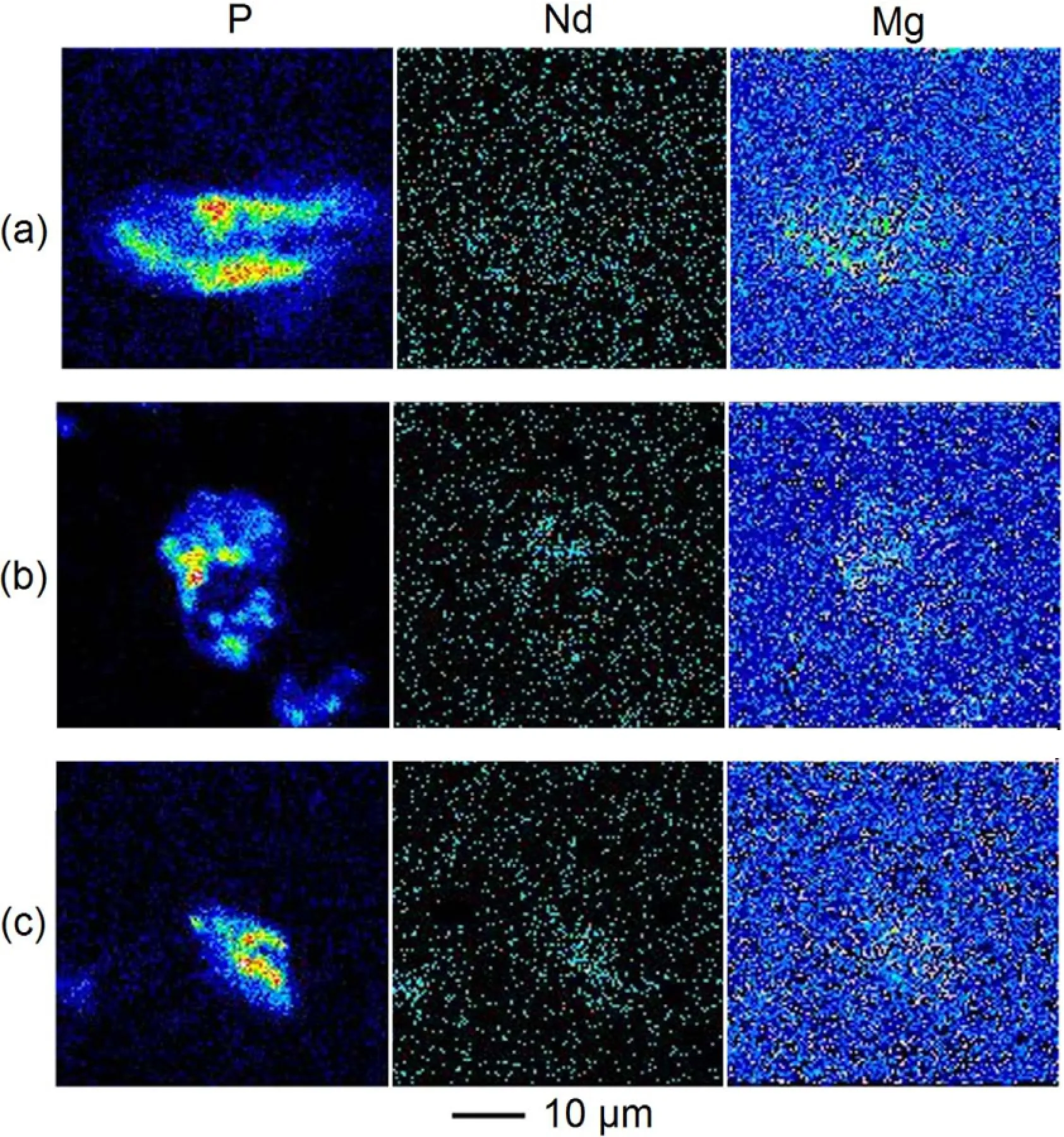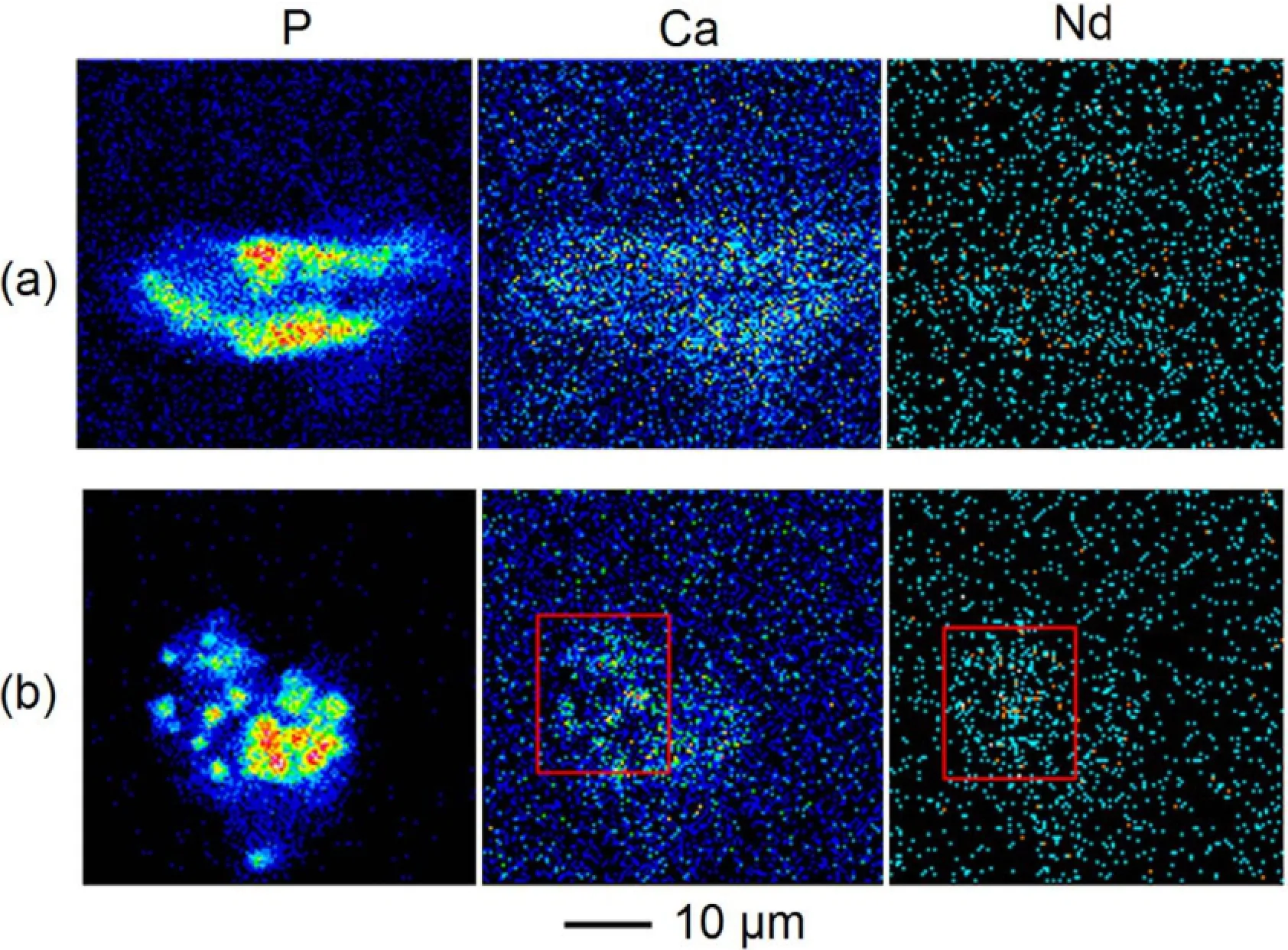External micro-PIXE analysis of Nd3+accumulation in Euglena gracilis∗
2014-03-07LIXinYi李忻忆SatohTakahiroYasuyukiIshiiTakeruOhkuboLIYongQiang李永强RENQingGuang任庆广RONGCaiCai荣彩彩HaoYan吕浩岩andSHENHao沈皓
LI Xin-Yi(李忻忆),Satoh Takahiro,Yasuyuki Ishii,Takeru Ohkubo,LI Yong-Qiang(李永强), REN Qing-Guang(任庆广),RONG Cai-Cai(荣彩彩),L¨U Hao-Yan(吕浩岩),and SHEN Hao(沈皓),
1Institute of Modern Physics,Applied Ion Beam Physics Laboratory,Fudan University,Shanghai 200433,China
2Takasaki Advanced Radiation Research Institute,Japan Atomic Energy Agency, 1233 Watanuki-machi,Takasaki,Gunma 370-1292,Japan
3Department of Radiation Oncology,Fudan University Shanghai Cancer Center,Shanghai 200032,China
4Department of Oncology,Shanghai Medical College,Fudan University,Shanghai 200032,China
5Research Center for Analysis and Measurement,Fudan University,Shanghai 200433,China
External micro-PIXE analysis of Nd3+accumulation in Euglena gracilis∗
LI Xin-Yi(李忻忆),1Satoh Takahiro,2Yasuyuki Ishii,2Takeru Ohkubo,2LI Yong-Qiang(李永强),3,4REN Qing-Guang(任庆广),5,†RONG Cai-Cai(荣彩彩),1L¨U Hao-Yan(吕浩岩),1and SHEN Hao(沈皓)1,‡
1Institute of Modern Physics,Applied Ion Beam Physics Laboratory,Fudan University,Shanghai 200433,China
2Takasaki Advanced Radiation Research Institute,Japan Atomic Energy Agency, 1233 Watanuki-machi,Takasaki,Gunma 370-1292,Japan
3Department of Radiation Oncology,Fudan University Shanghai Cancer Center,Shanghai 200032,China
4Department of Oncology,Shanghai Medical College,Fudan University,Shanghai 200032,China
5Research Center for Analysis and Measurement,Fudan University,Shanghai 200433,China
External micro-PIXE measurements were done to investigate the accumulation of Nd3+on green algae species euglena gracilis.According to the Nd distribution patterns in the gracilis cells,the biosorption of Nd3+to the cell’s compartments can be observed.Comparing elemental mappings of the cell treated with different doses of the 1mg/mL Nd3+solution,the Nd uptake of euglena gracilis cells do no relate with the doses.From distributions of Ca and Mg,it is found that the Ca is complementary to Nd partly,and the Nd and Mg distributions are alike to each other,showing that Nd may be mainly in the chlorophyll molecules.The biochemistry related is discussed.
Euglena gracilis cells,External micro-PIXE,Nd3+accumulation
I.INTRODUCTION
Biosorption of microorganisms,such as bacteria,fungi and algae,is a good means to accumulate heavy metal ions from water[1,2].Euglena gracilis,a unicellular green alga, demonstrates a remarkable ability to accumulate rare earth element(REE)cations to cell compartments.It was found that such cells could transport REE cations Nd3+actively against apparent gradient in the order of 5 or higher[3].Apart from its intrinsic interest,algal cells exhibiting this trait can be of value in application to biological elimination in aquatic environment for removing both toxic metal ions and organic contaminants.It is known that the cellular effects of lanthanide,including cell fusion,muscle relaxation,blood coagulation,etc.,are quite diverse[4].Since the last decade,the bio-medical aspects and toxicity of REE ions have been comprehensively reviewed[5–7].However,very little is known about the mechanism of the REE ion uptake process,intracellular transport and storage of REEs in cells.
Micro-PIXE has been successfully applied to many biological,medical and environmental problems with its high sensitivity and good spatial resolution.Additionally,using an external beam has many advantages,requiring no special sample preparations against vacuum environment,easier handling and observing the samples,reducing damage by heating and charging[8].In this paper,we study bioaccumulation of the REE cations Nd3+by measuring its distribution patterns in Euglena gracilis with external micro-PIXE,towards a better understanding of the accumulation process and its consequences for other ions.
II.EXPERIMENTAL
A.Cell culture and sample preparation
Euglena gracilis 848 was obtained from the Institute of Hydrobiology(Wuhan),Chinese Academy of Sciences.Details for the cell culture were described in Ref.[9].The cells were centrifuged by three cycles of re-suspension in de-ionized water to remove culture medium.The euglena 848 cell suspension(3mL)were syncretized with 1mL or 0.1mL of 1mg/mL NdCl3solutions.The cells,now loaded with metal ions,were further washed by three cycles of resuspension.Then,the cells were fixed by 0.25%glutaraldehyde(CHO(CH2)3CHO).The cell suspension in de-ionized water was dropped onto Mylar film with low cell density for single cell external micro-PIXE measurements.
B.External micro-PIXE
The external micro-PIXE experiments were carried out using the 3MV single-ended accelerator generating 3.0MeV proton beams on TIARA(Takasaki Ion Accelerators for Advanced Radiation Application)[8,10].A 2-µm-thick Mylar foil was used for the exit window to withstand the pressure differential.The cells were attached on the Mylar foil directly,so there is no air from target to the detector.The final resolution of the proton beam was 1.2µm.A Si(Li)X-ray detector(30mm2active area,energy resolution of 135eV) was placed in a vacuum chamber,so as to avoid interference from argon K X-rays,and located at 140◦with respect to the beam incidence.The detector window is 8µm beryllium.An annular type absorber(100-µm Mylar,with a Φ3mm hole) was used,for detecting Mg and P.DAQ software was capable of simultaneous processing signals from the detector.The beam current was 100–200pA.The cells were scanned with integrating charge of 130–200nC to obtain matrix and trace element distribution.

Fig.1.(Color online)Distributions of P,Nd and Mg in a single gracilis cell treated with different doses of 1mg/mL NdCl3solutions.(a) 0mL,(b)1mL,(c)0.1mL.The Nd and Mg distribution patterns are alike each other,showing Nd enrichment in chloroplasts.The scan size is 50µm×50µm.
III.RESULTS AND DISCUSSION
PIXE spectra of the cells were extracted from the raw scanning data according to their shapes.The intensity of neodymium L-X-rays was used to produce elemental mapping of the cells[1].Fig.1 shows elements distributions in gracilis cells treated with different doses of NdCl3solutions, with(a)being the control,and(b)and(c)being a cell treated with 1mL and 0.1mL of 1mg/mL NdCl3solutions,respectively.The cells in each group were randomly selected.
The distribution of phosphorus fit almost with the cell shape observed under a microscope,as phosphorus is the domain element of cell membrane.For Nd distribution,compared with group(a)and(b),there is no obvious local enrichment of Nd in the group of 1mL NdCl3(1mg/mL),while in the group of 0.1mL NdCl3(1mg/mL),the Nd distributed over the cell compartments.Evidently,Nd3+had been transported inside the cells.It is in accordance with our previous work done in Centre for Ion Beam Applications of National University of Singapore[11,12].Additionally,the results of cryosections of I4TCF-Nd3+stained cells and EDAX of fast freezing ultrathin cyosections,and as the experiments of electron microscopy on the alga[13],showed the same conclu-sion.Lansman[14]suggested that lanthanide ions were able to traverse the channel and enter the cell interior.Each alga cell is equipped with a single transport apparatus[15,16], which enables the Nd3+uptake.This shares some characteristic with calcium ion channels[13].Comparing Figs.1(b) and 1(c),with the cells having been treated with different doses of 1mg/mL Nd3+solution,the cellular uptake of Nd3+is independent of Nd3+concentration in the bulk solution, which had been proved by ICP-AES[9,13].

Fig.2.(Color online)Element mapping of a single gracilis cell in a 50µm×50µm scan area.(a)the control;(b)treated with 1mL of 1mg/mL NdCl3solutions.Red rectangles show that Ca is complementary to Nd partly in the cell loaded with Nd,while this phenomenon could not be seen markedly in the control sample.
It is known that chloroplasts are the major compartments as the residences of Nd[13].In nature,magnesium is the coordination center of chlorophyll.Lanthanide-substituted chlorophyll has been investigated[17,18].EXAFS(extended X-ray absorption fine structures)results suggest that exogenouslanthanidemightsubstituteforthemagnesiuminchlorophyll after it is transported to the interior of algal cells[19]. Energy-dispersive X-ray microanalysis(EDXA)was used to investigate chloroplasts.A characteristic peak of lanthanide in chloroplasts appeared clearly[13].Also,in Figs.1(b) and 1(c),the Nd and Mg distribution are of similar patterns. This provides again good evidence that loaded neodymium may couple with chlorophyll.In addition,comparing with the control,the Mg content in the treated cells deceased approximately by 70%,in both Figs.1(b)and 1(c),showing that Nd substitutes for Mg in chlorophyll after it is transported into the cell.
Figure 2 shows Ca and Nd distributions in a single cell from the control and the Nd3+-treated cells.Although the Ca and Nd distributions differ from each other,it can be found(see the red rectangle)that calcium is complementary to neodymium partly in the cell loaded with Nd,while this phenomenon cannot be seen markedly in the control sample. Probably,this indicates that the Ca content decreased after uptake of the Nd cations.The distribution radius of the rare earth ions is very close to that of Ca2+;they can bind with some bio-macromolecules to form coordination compounds and replace Ca2+on protein in binding sites[4,20].
IV.CONCLUSION
Nd3+accumulation in euglena 848 cells is revealed by external micro-PIXE analysis,and the relationships of the Nd distribution pattern with that of Ca and Mg are investigated. The neodymium ions traverse the channel and enter into the cell.Probably,theyreplacecalciumionsonproteininbinding sites,and the magnesium ions in chlorophyll,being enriched in chloroplasts.A deeper understanding of the Nd transport mechanism requires further investigation.
[1]Guo P,Wang J,Li X,et al.Nucl Instrum Meth B,2000,161–163:801–807.
[2]WangHKandWoodJM.EnvironSciTechnol,1984,18:106–109.
[3]Kang L,Shen Z Q,Jin C Z.Chinese Sci Bull,2000,45:585–591.
[4]Shen H,Ren Q G,Mi Y,et al.Nucl Instrum Meth B,2002, 189:506–510.
[5]Hirano S and Suzuki K T.Exposure metabolism and toxicity of rare earths and related compounds.Environ Health Perspect. 1996,104(suppl 1):85–95.
[6]Ni Z J.Bioinorganic Chemistry of Rare Earth Elements.Beijing(China):Science Press,1995.
[7]Brown P H and Rathjen A H,et al.Handbook of Physics and Chemistry of Rare Earths.Amsterdam(Netherlands):Elsevier Science Publishers,1990.
[8]Sakai T,Kamiya T,Oikawa M,et al.Nucl Instrum Meth B, 2002,190:271–275.
[9]Jin C Z,Kang L,Shen Z Q,et al.Acad Period Abstr China, 1998,4:976–980.(in Chinese)
[10]Sakai T,Oikawa M,Sato T,et al.Nucl Instrum Meth B,2005, 231:112–116.
[11]Zheng Y.Ph.D.Thesis,Fudan University,2012.(in Chinese)
[12]Ren M Q,Chen X,Zheng Y,et al.X-Ray Spectrom,2013,42: 237–241.
[13]Kang L,Shen Z Q,Jin C J.Chinese Sci Bull,2000,45:585–591.
[14]Lasman J B.J Gen Physiol,1990,95:679–696.
[15]Wolken J J.Euglena:An Experimental Organism for Biochemical and Biophysical Studies,ed.2.New York(USA): Appleton-Century-Crofts,1967.
[16]Miller R J.Science,1987,235:46–52.
[17]Wu Z Y,Tao Y,Benfatto M,et al.J Synchrotron Radiat,2005, 12:98–101.
[18]Hong F S,Wei Z G,Zhao G W.Sci China Ser C,2001,31: 392–400.(in Chinese)
[19]Ren Q G,Hua Y,Shen H,et al.J Radioanal Nucl Ch,2007, 272:359–362.
[20]Wang K.Trace Elements in Life Science.Beijing(China):Chinese Measuring Press,1992.(in Chinese)
(Received January 23,2014;accepted in revised form March 25,2014;published online July 26,2014)
10.13538/j.1001-8042/nst.25.040201
∗Supported by the National Natural Science Foundation of China(Nos. 10675033 and 10975034)
†qgren@fudan.edu.cn
‡haoshen@fudan.edu.cn
杂志排行
Nuclear Science and Techniques的其它文章
- Development of a beta radioluminescence nuclear battery∗
- Apparatus for determining permeability of hydrogen isotopes in molten-salt
- A facile method to build a proton nanosensor with neutral to basic pH sensitive range∗
- The flow characteristics of fluid in micro-channels of different shapes∗
- Hadron multiplicities in p+p and p+Pb collisions at the LHC∗
- An investigation on neutron induced reactions on stable CNO isotopes∗
